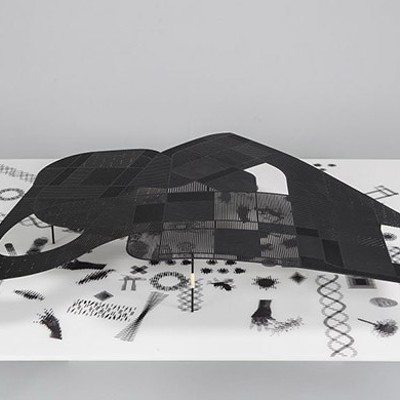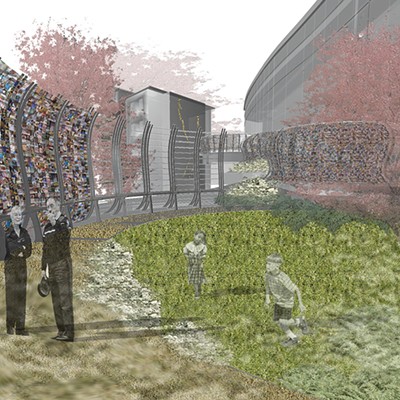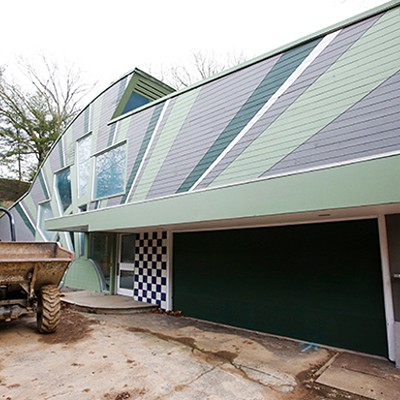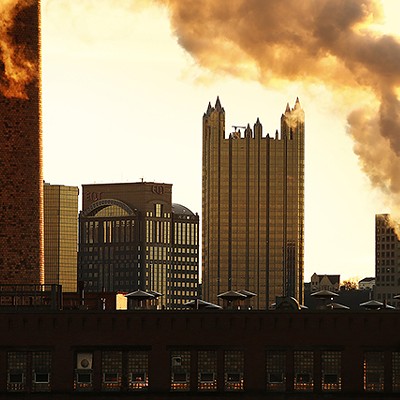When Jared the Subway guy introduces a commercial by saying, "I approve this message," no one is really amused, but they aren't surprised, either. The supersaturation of political messages means that even the least clever ad executive will be tempted to create a parody of an annoying campaign spot. Because it's absolutely hilarious to suggest that buying a sandwich is as important as voting in a national election. Or maybe it's a little too close to the truth.
Either way, the corporate interests are out to sway the opinion of the mass audience toward the goal of influencing economic decisions. Thank you, television!
All efforts at trivialization aside, we still have meaningful choices about how to change the world around us for the better. That is certainly the message of AIA (American Institute of Architects) Design Pittsburgh 2004 program. The multi-week series of events and exhibitions centers on the 101 projects, presented on identically sized square presentation boards, that local and regional designers have submitted to the AIA awards program.
These submissions were shown in the US Steel Tower for 11 days, with a concluding display at the Carnegie Museum of Art on Oct. 19 and 20. (A longer period of exhibition, more accessible than the terror-phobic Steel Tower lobby, would have been nice.) William H. Fain Jr., noted architect and planner from Los Angeles, will choose the projects that will receive honors and announce them just as this issue goes to print.
Within this context, the AIA is like television, in both positive and negative ways. It aims to bring a commercial promotional message -- hire an architect for your building project! -- to a mass audience in an informative and entertaining way. It also has a certain homogenizing effect on the results, again with both good and bad results.
The 3-foot-square presentation board is the 30-second spot of architectural awards. The advantage is that the consistent format levels the playing field for all variety of firms and projects. Theoretically, the viewer can tell the difference between an accomplished contender and a ham sandwich. To a certain degree, this is true. Among an oversupply of astonishingly dull schools and academic buildings, a project such as Pfaffmann + Associates' Carport Pavilion stands out. It uses rich materials, crisp detailing and a pleasantly fluid sense of space to make art out of an otherwise dull building type. It also has the advantage that an elegant little pavilion, nicely photographed, is comparatively easy to understand.
Likewise the Design Alliance Architects' Paul H. O'Neill Office. For a client who prides himself on openness (perhaps too much of it for the Bush administration's taste), one of Pittsburgh's most experienced designers of corporate interiors has combined the light-filled visual openness of expansive glass walls with a sense of restraint that is both corporate and Zen-like. This design epitomizes a sense of having nothing to hide.
But what about Klavon Design Associates South Side 10-1 Riverfront Trail?
This is an ambitious and sprawling landscape design plan for a section of the south bank of the Monongahela between the 10th Street and Liberty Bridges. It's simply harder for the average person to read a blocks-long landscape plan when they have just come away from photographs of obviously artful wood and glass details. Fortunately, projects of this scope are judged separately, but the contest format does this project a disservice. Still, the design is particularly worthwhile. Klavon's approach is historically informed and esthetically satisfying, but it also shows an elaborate understanding of ways to realize the enormous potential of the riverfront.
You might react similarly to Rothschild Doyno Architects' Vision for the Center of East Liberty. It takes knowledge of the area and patience reading the firm's documentation to appreciate its outstanding urban-design assessments.
In recent years, the AIA has admirably expanded its scope by including a broader range of projects. Organizers ought to act further on this inclination and consider including non-professionals such as artists and students as well as non-AIA members. That might seem to go against some principles of their organization. But it would meet the most important one, which is to elevate the quality of debate about architecture, landscape and urban design.


















